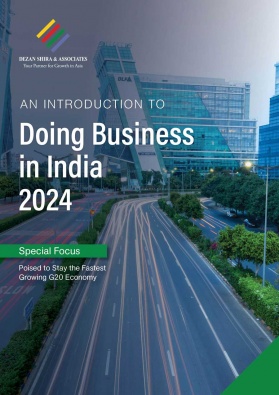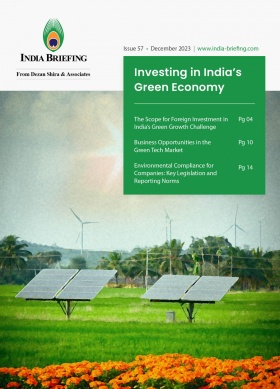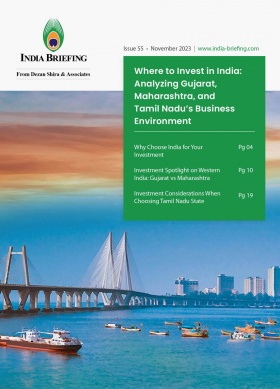Ahead of Interim Budget and in an Election Year, India’s Chief Economic Advisor Releases a State of the Economy Report
India’s Chief Economic Advisor, V Anantha Nageswaran, released a 74-page document outlining the Indian economy’s progress, anticipating a 7.3 percent growth rate in FY 2023-24. Despite not being an “Economic Survey,” the report highlights key factors contributing to growth, including macroeconomic stability, resilient service exports, and reduced oil import costs, resulting in a 1 percent GDP current account deficit in H1 FY24. Emphasizing the digital revolution, supportive regulations, socio-economic measures, niche manufacturing, and infrastructure development, the report underscores governmental reforms aimed at fostering economic growth and stable governance.
India’s Chief Economic Advisor to the government, V Anantha Nageswaran, and his team of economists have released a 74-page document titled “The Indian Economy: A Review” ahead of the interim budget scheduled to be announced February 1, 2024. The document release has come as a surprise to many since traditionally an economic survey report is released ahead of union budget announcements.
The chief economist, however, has clarified that the document is not an “Economic Survey of India” but rather highlights the journey and progress of the Indian economy in this decade. The report entails the country’s vision to achieve a US$7 trillion economy by 2030 within the next 6-7 years, along with key economic challenges anticipated.
The report underscores the significance of both domestic performance and global factors in driving economic growth, emphasizing the impact of slowing hyper-globalization and friend-shoring trends on trade and overall economic expansion.
Identifying challenges in the Indian economy
In the past nine years, India’s impressive economic growth driven by reforms has come with its share of challenges. This section highlights key issues:
- Global integration impact: India’s growth is no longer solely determined by domestic factors but is significantly influenced by global developments. Geoeconomic fragmentation and the slowdown of hyper-globalization are leading to increased friend shoring and onshoring activities, impacting global trade and economic growth.
- Energy security vs. sustainability: Balancing energy security, economic growth, and the transition to sustainable energy sources poses a complex challenge. This multidimensional issue involves considerations in geopolitics, technology, fiscal policy, economics, and social aspects. Individual countries’ policy decisions in pursuit of energy goals can have widespread effects on other economies.
- Artificial intelligence (AI) challenge: The rise of AI poses a substantial challenge globally, especially in service sectors where employment is a concern. A recent IMF paper highlights that 40 percent of global employment is exposed to AI, showcasing both its complementary benefits and potential risks of displacement. Developing economies are urged to invest in infrastructure and cultivate a digitally skilled workforce to harness AI’s full potential.
- Domestic workforce and education: Internally, ensuring a skilled workforce for industries, achieving age-appropriate learning outcomes at all educational levels, and promoting a healthy population are critical policy priorities. A healthy and well-educated populace significantly contributes to an economically productive workforce.
Drivers of India’s growth in the last decade
Nageswaran’s report highlights India’s economic policy focus over the past decade, which has led to growth by reviving the financial sector, improving business conditions, and improving physical and digital infrastructure through various economic reforms. The reforms, according to the report, have created an environment conducive to business, improved the quality of life, and enhanced governance systems.
It highlights key measures such as recapitalization, merger of 10 public sector banks, and the Insolvency and Bankruptcy Code (IBC) as contributing factors leading to cleaner balance sheets and resolving distress for many corporate debtors.
Regulatory frameworks have also been simplified with the introduction of the unified goods and services tax (GST) and reduced tax rates for individuals and businesses. This has formalized the economy.
Government of India’s Report Card on Entrepreneurship
- 1,14,902 DPIIT-recognized startups across 763 districts of the country (as of October 31, 2023).
- 445 million loans worth INR 26.1 trillion were sanctioned under the MUDRA Yojana, with 68 percent of accounts belonging to women entrepreneurs.
- Under PMSVANidhi, 8.23 million loans were sanctioned to over 5.8 million street vendors, with a total value exceeding INR 109.22 billion (as of January 11, 2024).
- Under DAY-NRLM, 95 million women mobilized into 8.74 million Self-Help Groups (SHGs) under DAY-NRLM (as of December 2023).
- Under Stand-Up India, 210,000 loans have been sanctioned, of which 84 percent have been sanctioned to women entrepreneurs (as of November 24, 2023).
Reviewing resilience of India’s external sectors
Nageswaran’s report states that India’s external sector has shown resilience, with notable performance in merchandise trade.
“Exports, reaching record-high levels since FY22, saw a remarkable rise of over 50 percent in merchandise exports and 120 percent in service exports over the past decade (FY13 to FY23). While FY23 achieved the highest-ever merchandise export of US$451.1 billion, the growth rate moderated in FY23 due to persistent geopolitical tensions. Merchandise imports grew by 16.8 percent in FY23.”
The document also highlights that despite a slowdown in merchandise exports during FY24, India’s merchandise trade balance improved significantly from a deficit of US$189.2 billion in April-November 2022 to US$166.4 billion in April-November 2023 due to a decline in imports. Nageswaran states that the export mix has seen progressive diversification, and there is potential to enhance the quality and complexity of exports.
India’s business services’ share in total services exports has gradually increased since FY 2019-20, and both business services and financial services experienced double-digit growth since FY 2021-22, aligning with the overall surge in software and services exports.
Total exports (merchandise plus services) have shown an upward trend since FY22, reaching US$781.4 billion in FY23. Efforts are underway to enhance production capacity and export promotion, aiming for a target of US$2 trillion in exports by 2030.
“Measures include setting export targets, monitoring progress, providing export credit insurance services, and encouraging affordable and adequate export credit to MSME exporters for exploring new markets and diversifying products competitively,” the Chief Economic Advisor has noted in the report.
The role of digitization and skilled workforce
CEA Nageswaran highlights the consistent emphasis on technology and digital platforms as a unifying theme across the nine years of reform initiatives. He suggests that other economies can draw inspiration from India’s digitization policies, which have resulted in increased formalization, greater financial inclusion, and expanded economic opportunities. The digital infrastructure has played a pivotal role in fostering both steady and rapid economic growth over the past decade by facilitating the establishment of digital identities, improving market and financing access, reducing transaction costs, and enhancing tax collection.
The CEA attributes the positive outcome of robust digital infrastructure to the surge in service exports. Acknowledging the significant contribution of service exports to GDP, the report underscores the impact of increased demand for digitization and a preference for online service delivery post-pandemic, particularly in driving the export of business services.
The presence of a highly skilled workforce proficient in research, innovation, advanced technology usage, and managerial skills has attracted the establishment of Global Capability Centers (GCC), supporting critical corporate functions. Citing a Bloomberg article titled “Goldman’s Biggest Office Beyond New York Attests to India’s Rise, Nageswaran says India’s enhanced digital and physical infrastructure solidifies its standing as a favored destination for GCCs.
The report claims that the GCCs now contribute over 1 percent to India’s GDP, underscoring their role in reinforcing the resilience of the country’s service exports. These exports include GCC activities, along with professional business services, such as research and development (R&D), management consulting, public relations, and engineering services. The increased emphasis on digitization and online service delivery, particularly post-pandemic, has significantly propelled the growth of business service exports from India.
Paving way for women-led inclusive growth
The report highlights that the Women’s Reservation Bill (Nari Shakti Vandan Adhiniyam) passed in September 2023 aligns with India’s G20 Presidency focus on “women-led development.”
The document suggests that via PM Jan Dhan Yojana, women have gained better financial service, resulting in improved control over household resources. The proportion of women with bank accounts they use personally increased from 53 percent in 2015-16 to 78.6 percent in 2019-21.
Women-led SHGs have demonstrated significant positive impacts on economic, social, and political empowerment. The government’s Deendayal Antyodaya Yojana-National Rural Livelihood Mission (DAY-NRLM) has played a pivotal role in empowering nearly nine crore women through 8.3 million SHGs, positively influencing education, participation in village institutions, and access to government schemes.
The female labor force participation rate increased to 37 percent in 2022-23 from 23.3 percent in 2017-18, indicating a transformative shift toward women-led development in India, per the report.
India on a positive growth trajectory
Chief Economist Nageswaran is confident that India’s economic growth will remain robust, supported by macroeconomic stability. The official estimate for FY24 is a growth rate of 7.3 percent, with a gradual decline in headline inflation. Factors contributing to this positive outlook include resilient service exports and reduced oil import costs, leading to a current account deficit of 1 percent of GDP in H1 FY24 (April-September 2023).
In conclusion, the strengthened and predictable economic and financial cycles indicate India’s readiness for sustained and brisk growth in the future. Sub-national government reforms focusing on streamlining regulatory obligations for MSMEs, ensuring land availability at reasonable prices, and addressing energy needs are all cumulatively expected to further accelerate economic growth. Overall, India is poised for continuous and robust economic expansion.
About Us
India Briefing is produced by Dezan Shira & Associates. The firm assists foreign investors throughout Asia from offices across the world, including in Delhi and Mumbai. Readers may write to india@dezshira.com for more support on doing business in India.
We also maintain offices or have alliance partners assisting foreign investors in Indonesia, Singapore, Vietnam, Philippines, Malaysia, Thailand, Bangladesh, Italy, Germany, and the United States.
- Previous Article How Tamil Nadu’s Footwear Industry is Competing with Southeast Asian Markets
- Next Article India Cuts Import Duty on Mobile Phone Components from 15% to 10%









